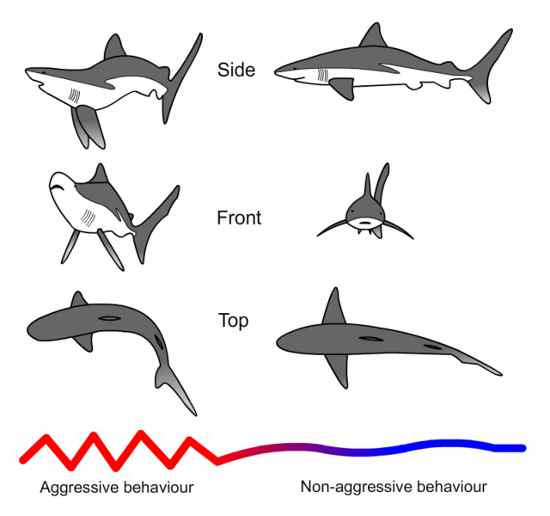How To Survive A Shark Attack - A Six Step Plan For Staying Safe In The Water

Although shark attacks are rare, and the risk is often minimal, they do still occur so here at Ready Tribe, we thought you guys and gals might like a few tips on what you can do to survive being attacked by a shark.
When these great sea beasts do attack it is usually because a shark is looking for non-human prey and/or they have become trapped and subsequently agitated at low tide, possibly between sandbars or inshore of a sandbank. As there is always a risk, however slight, it is worth taking some minor precautions in order to mitigate that risk.
- Try not to swim too far from the shore
- Try and stay in groups as sharks are less likely to attack a group than an individual
- Stay out of the water during a sharks most active periods i.e. in darkness and twilight
- Never enter the water if you are bleeding from an open wound. Sharks are attracted to blood!
- Do not wear shiny jewelry in the sea as this could resemble fish scales shimmering - prime shark prey
- Get yourself a Shark Shield for additional safety
So what do you do if you see a shark in the water?
Step 1: Staying calm is vital!
Do your best to stay as calm as possible. There are only a small number of species of sharks that will attack humans when not provoked. They are generally bull sharks, tiger sharks, and great whites and it is not likely that you will be in the same vicinity as them! It is more likely that you will come face to face with one of the smaller species of sharks and it is unlikely they will attack you - as long as they do not feel threatened.
Step 2: Try and Swim away as smoothly as possible
If you do come across a shark in the water then you should swim away as quietly as possible. Creating a commotion by screaming and splashing about may alert the shark to your presence and may also make them feel alarmed which could lead to them attacking you.

Pic: www.world-of-sharks.com
Step 3: Try And Take Cover
If the shark is displaying aggressive behavior and is swimming directly towards you then attempt to take cover against something so that you minimize the parts of your body that can be struck by the shark. If you are in the water with someone else then you may want to go back to back to help increase the chances of survival. If diving, head to the surface whilst remaining in a back to back formation with your dive buddy.
Step 4: Make Sure You Fight Back!
if you fond that the shark is coming at you then fight back by kicking and punching it. Aim for its areas of weakness such as its gills, eyes and nose.
Step 5: Make Sure You Help Other People
There is power in numbers so if you can scare the shark off when it is attacking someone else, do so.
Step 6: Don't Let This Stop You Enjoying Yourself In The Water
Although there is a risk of shark attack, it is a very minimal one so do not be put off from enjoying yourself in the sea. Below the video is some facts about shark attacks. Remember: your chances of being attacked by a shark are one in 11.5 million - pretty low odds!
Check out these cool Shark Attack facts from National Geographic:
- 93% of shark attacks from 1580 to 2010 worldwide were on males.
- In 2010, North American waters had 42% of all confirmed unprovoked shark attacks worldwide (32 attacks).
- Surfers accounted for 50.8% of all attacks in 2010.
- Swimmers and waders accounted for 38% of all attacks in 2010.
- Snorkelers and divers accounted for 8% of all attacks in 2010.
- Inflatable rafts and inner tubes accounted for 3% of all attacks in 2010.
- 2010 was the most dangerous year for unprovoked shark attacks in a decade, with 79.
- Over the last half-century, there have been more unprovoked shark attacks in Florida (27 out of a total 139) between 2 p.m. and 3 p.m. than at any other time of day.
- New Smyrna Beach in Florida is the shark attack capital of the world according to International Shark Attack File. It is estimated that anyone who has swam there has been within 10 feet of a shark.
- September is the month with the most shark attacks in Florida.
- Since 1907, 201 out of 220 great white attacks have occurred when the human was less than 6 feet from the surface.
- You have a 1 in 63 chance of dying from the flu and a 1 in 11 million chance of being killed by a shark during your lifetime.
- Over 17,000 people die from falls each year. That’s a 1 in 218 chance over your lifetime, compared to a 1 in 11 million chance of being killed by a shark.
- In 1996, toilets injured 43,000 Americans a year. Sharks injured 13.
- In 1996, buckets and pails injured almost 11,000 Americans. Sharks injured 13.
- In 1996, 2,600 Americans were injured by room fresheners. Sharks injured 13.
- The U.S. averages just 19 shark attacks each year and one shark attack fatality every two years. Meanwhile, in the coastal states alone, lightning strikes and kills more than 37 people each year.
- Since 1959, Florida has had more shark attacks (603) than lightning fatalities (459).
- Since 1959, California has had more shark attacks (89) than lightning fatalities (30).
- Since 1959, Hawaii has had 97 shark attacks but no lightning fatalities.
- Only five people die from shark attacks yearly, while millions of people die from starvation.
- Since 1905, Natal (where Durban is) has had 89 shark attacks and 27 fatalities.
- For every human killed by a shark, humans kill approximately two million sharks.
- Most shark attacks occur less than 100 feet from the shore, mainly around popular beaches in North America (especially Florida and Hawaii), Australia, and South Africa.
- In 2008, a polar bear jaw was found in a Greenland shark's stomach.


